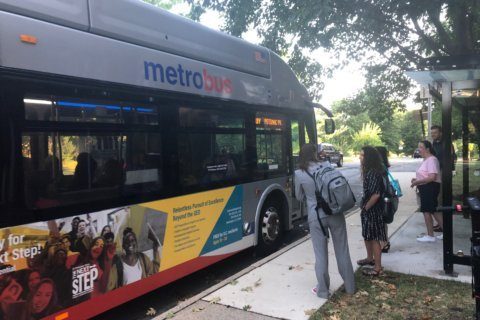
Metro believes that while frustration from the ongoing Blue and Yellow Line shutdown may have dented its ridership, its numbers will bounce back when service resumes in September.
Despite complaints about shuttle buses from missed trips to increased traffic, Metro General Manager Paul Wiedefeld predicts the estimated 40% of impacted commuters who have found alternatives to shuttles will hop on trains again starting Sept. 9.
“The reality is some of this happens obviously during summer, so people make different plans, but I think the quality of the service has improved such that they want to get back to us as quickly as they can,” Wiedefeld said Thursday.
“Anyone that drives every day knows the frustration of that.”
Though Metro ridership is down sharply over the last decade, he pointed to increases in rail ridership over the first part of this year compared to last. Metrobus ridership remains down sharply.
“As we keep focusing on reliability, that will bring people back,” Wiedefeld said.
Riders who have stuck with Metro or other transit during the monthslong closure of all stations south of Reagan National Airport have seen their own frustrations, though.
Waiting at Slaters Lane and East Abingdon Drive at the north end of Old Town Alexandria on Thursday morning, commuter Lauren Lobrano said she and fellow Metrobus 11Y riders have been left stranded multiple times by overcrowded buses.
“There have been days where that’s happened two or three times, so we’re just stranded here trying to get to work,” she said.
It is even more frequent in evenings leaving downtown D.C., despite Metro promises to expand capacity on the express route during the shutdown. It has left some people stuck paying for an expensive Uber, Lyft or cab to get home.
Data compiled by the independent app MetroHero, based on Metrobus GPS and schedule data, shows Metro only met its promised number of trips on the 11Y one morning, and one afternoon, since June 3.
There are sometimes buses that do not show up on the data due to GPS, systems or schedule data issues, but the difference between the number of observed and scheduled trips is dramatic on many days.
That led Metro to permanently post advice to riders on other possible options when there are problems with 11Y service — but those alternatives are much slower: Metro to Pentagon to take the 10A or 10E, or the Pentagon to Huntington Express shuttle to Fairfax Connector Route 101 from Huntington.
MetroHero data from Route 7Y shows far fewer missed trips. Metro has told the Riders Advisory Council that some extra or longer 11Y buses were shifted to support shuttle bus routes.
“We continue to work that. Daily, we may have some issues, but overall, our experience has been pretty good, and I think the customers have reflected that — their usage is reflecting that,” Wiedefeld said, addressing bus rider complaints.
He described the number of people using Metro’s shuttles and other buses as “one of the surprises” of the shutdown.
“We’ve retained almost 60-some percent of the previous people that used the system, just on the shuttle buses, so that’s fantastic,” Wiedefeld said. “We’re starting to think through, obviously, next year’s shutdown as well.”
Lobrano has commuted on the 11Y for more than a decade.
“We would just like to see some consistency, or at least some communication. You know, set expectations, follow through when you can. When you can’t, explain why. Tell us what’s going on. Don’t let us just grasp for nothing,” Lobrano said.
She described Metro as “mostly nonresponsive” to her complaints submitted online or through social media.
“There should have been a plan B or a plan C in place so that people can get to and from work,” Lobrano said. “Hopefully, we’ll see some improvements in the last month.”










